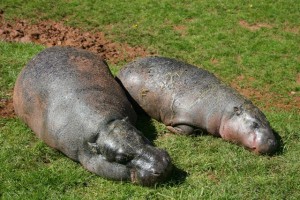PYGMY HIPPOPOTAMUS BEHAVIOR

Both species of hippopotamus lose moisture from the skin very quickly. While a humid climate is enough to keep the Pygmy Hippopotamus from dehydrating, the Nile Hippopotamus needs to spend most of the day submerged in water. When in the water, the Nile Hippopotamus’s ears, eyes and nostrils are placed high on the head, so that it can breathe and keep watch of it’s surroundings.
They make ‘tunnels’ or cleared paths in the underbrush. these tunnels are use to travel through their territory. They are excellent swimmers and walk on the bottom of a river. The nostrils can be closed with muscular valves, which allow them to remain under water for up to 6 minutes. When a predator threatens, like a leopard, they will try to escape into the water or into thick underbrush.
Pygmy hippo have numerous resting places throughout their territory, which they use exclusively when sleeping. They rest in areas that are moist to wet terrain. Pygmy hippopotamus seek food on higher, drier ground, and are active between 6 pm and midnight. Males and females, both have home ranges, though the males occupy much larger than those of females: a female’s range covering 100-150 acres, and a male’s covering about 400 acres. Despite extensive overlapping of home ranges, pygmy hippopotamuses rarely meet others of their species. Pygmy hippopotamuses actively avoid encounters with others, territories being marked through dung marking. Most movements are along ‘roads’ – cleared paths, canals, and tunnels, used by many hippos. During the breeding season, males seek out receptive females, who tolerate the males’ presence when in heat. They mate on land and in the water throughout a period of two days, 1-4 copulations may occur.
When threatened, the pygmy hippo usually flee: trotting a short distance into dense jungle. Then hide till the danger has passed. Normally silent, they sometimes snort, grunt, hiss, groan, and squeak.
